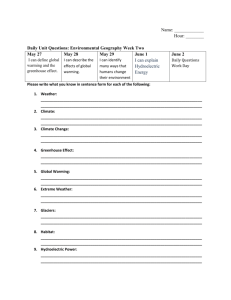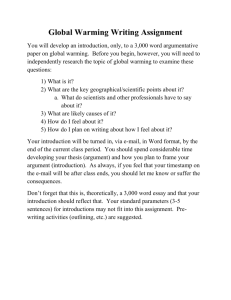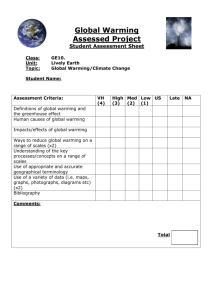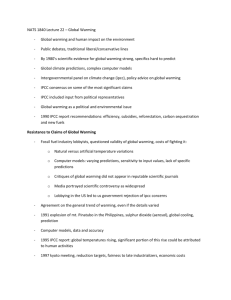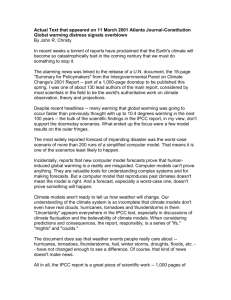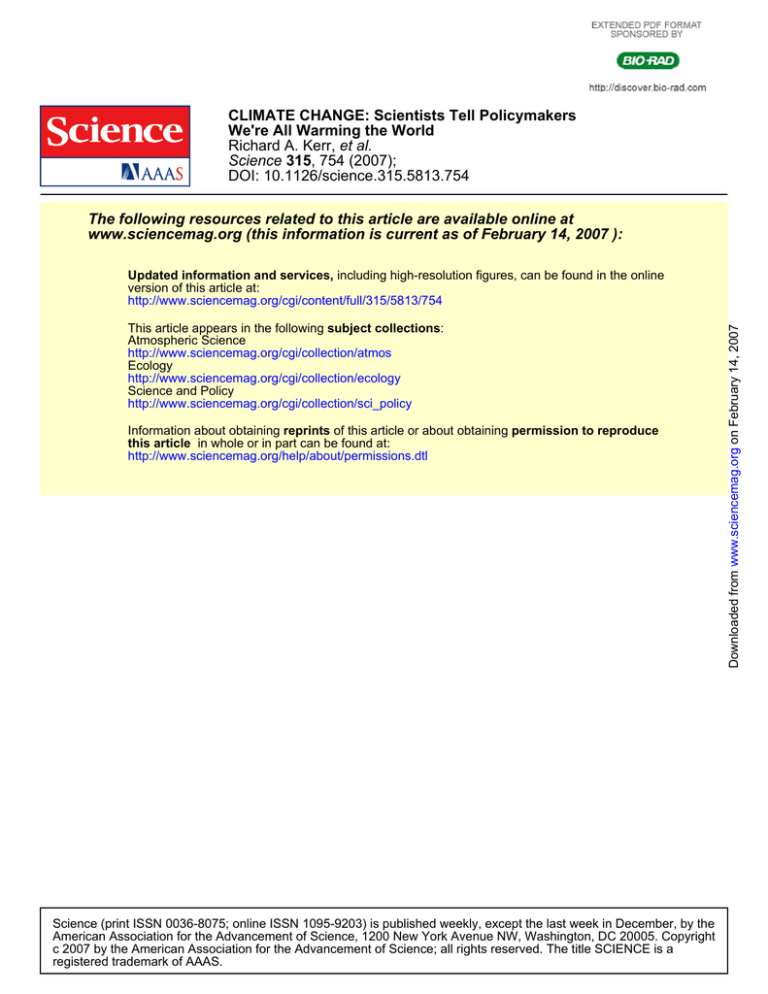
CLIMATE CHANGE: Scientists Tell Policymakers
We're All Warming the World
Richard A. Kerr, et al.
Science 315, 754 (2007);
DOI: 10.1126/science.315.5813.754
The following resources related to this article are available online at
www.sciencemag.org (this information is current as of February 14, 2007 ):
This article appears in the following subject collections:
Atmospheric Science
http://www.sciencemag.org/cgi/collection/atmos
Ecology
http://www.sciencemag.org/cgi/collection/ecology
Science and Policy
http://www.sciencemag.org/cgi/collection/sci_policy
Information about obtaining reprints of this article or about obtaining permission to reproduce
this article in whole or in part can be found at:
http://www.sciencemag.org/help/about/permissions.dtl
Science (print ISSN 0036-8075; online ISSN 1095-9203) is published weekly, except the last week in December, by the
American Association for the Advancement of Science, 1200 New York Avenue NW, Washington, DC 20005. Copyright
c 2007 by the American Association for the Advancement of Science; all rights reserved. The title SCIENCE is a
registered trademark of AAAS.
Downloaded from www.sciencemag.org on February 14, 2007
Updated information and services, including high-resolution figures, can be found in the online
version of this article at:
http://www.sciencemag.org/cgi/content/full/315/5813/754
NEWSFOCUS
Downloaded from www.sciencemag.org on February 14, 2007
Hot times. It won’t get
this bad, but the world
will warm substantially.
They’ve said it before, but
this time climate scientists
are saying it with feeling:
The world is warming; it’s
not all natural, it’s us; and if
nothing is done, it will get
a whole lot worse
THE LAST TIME THE INTERGOVERNMENTAL
Panel on Climate Change (IPCC) assessed
the state of the climate, in early 2001, it got a
polite enough hearing. The world was warming, it said, and human activity was “likely” to
be driving most of the warming. Back then,
the committee specified a better-than-60%
chance—not exactly a ringing endorsement.
And how bad might things get? That depended
on a 20-year-old guess about how sensitive the
climate system might be to rising greenhouse
gases. Given the uncertainties, the IPCC
report’s reception was on the tepid side.
Six years of research later, the heightened
conf idence is obvious. The warming is
“unequivocal.” Humans are “very likely”
(higher than 90% likelihood) behind the
warming. And the climate system is “very
unlikely” to be so insensitive as to render
future warming inconsequential.
This is the way it was supposed to work,
according to glaciologist Richard Alley of
Pennsylvania State University in State
College, a lead author on this IPCC report.
“The governments of the world said to scien-
754
tists, ‘Here’s a few billion dollars—get this
right,’ ” Alley says. “They took the money, and
17 years after the first IPCC report, they got it
right. It’s still science, not revealed truth, but
the science has gotten better and better and
better. We’re putting CO2 in the air, and that’s
changing the climate.”
With such self-assurance, this IPCC
report may really go somewhere, especially
in the newly receptive United States (see
sidebar, p. 756), where a small band of scientists has long contested IPCC reports.
Coordinating lead author Gabriele Hegerl
of Duke University in Durham, North Carolina, certainly hopes their report hits home
this time. “I want societies to understand
that this is a real problem, and it affects the
life of my kids.”
Down to work
Created by the World Meteorological Organization and the United Nations Environment
Programme, the IPCC had the process down
for its fourth assessment report. Forty governments nominated the 150 lead authors and
9 FEBRUARY 2007
VOL 315
SCIENCE
Published by AAAS
450 contributing authors of Climate Change
2007: The Physical Science Basis. There was
no clique of senior insiders: 75% of nominated lead authors were new to that role, and
one-third of authors got their final degree in
the past 10 years. Authors had their draft
chapters reviewed by all comers. More than
600 volunteered, submitting 30,000 comments. Authors responded to every comment,
and reviewers certified each response. With
their final draft of the science in hand, authors
gathered in Paris, France, with 300 representatives of 113 nations for 4 days to hash out
the wording of a scientist-written Summary
for Policymakers.
The fact of warming was perhaps the most
straightforward item of business. For starters,
the air is 0.74°C warmer than in 1906, up from
a century’s warming of 0.6°C in the last report.
“Eleven of the last twelve years rank among
the 12 warmest years in the [150-year-long]
instrumental record,” notes the summary
(ipcc-wg1.ucar.edu). Warming ocean waters,
shrinking mountain glaciers, and retreating
snow cover strengthened the evidence.
www.sciencemag.org
CREDIT: ROB ATKINS/THE IMAGE BANK/GETTY IMAGES
Scientists Tell Policymakers
We’re All Warming the World
CREDITS (TOP TO BOTTOM): IPCC; CHARLES PLATIAU/REUTERS/LANDOV
NEWSFOCUS
www.sciencemag.org
SCIENCE
Published by AAAS
VOL 315
9 FEBRUARY 2007
Downloaded from www.sciencemag.org on February 14, 2007
So the IPCC authors weren’t impressed by how hard the climate system was driven dur- past 15 years, but 50% faster than the warmthe contrarian argument that the warming is ing long-past events such as the last ice age ing of the past 50 years. By the end of this
just an “urban heat island effect” driven by and how much climate changed then. And century, global temperatures might rise anyincreasing amounts of heat-absorbing con- models have converged on a narrower range where between a substantial 1.7°C and a
crete and asphalt. That effect is real, the report of climate sensitivity.
whopping 4.0°C, depending on the amount
says, but it has “a negligible influence” on the
The IPCC concludes that both models and of greenhouse gases emitted. In some model
global number. Likewise, new analyses have past climate changes point to a fairly sensitive projections, late-summer Arctic sea ice all
largely settled the hullabaloo over why ther- climate system. The warming for a doubling of but disappears late in this century. It is very
mometers at Earth’s surface measured more CO2 “is very unlikely to be less than 1.5°C,” likely that extremes of heat, heat waves, and
warming than remote-sensing satellites had says the report, not the less than 0.5°C favored heavy precipitation events will continue to
detected higher in the atmosphere (Science, by some contrarians. A best estimate is about become more frequent. Rain in lower lati12 May 2006, p. 825). Studies by several 3°C, with a likely range of 2°C to 4.5°C.
tudes will decrease, leading to more drought.
groups have increased the satellite-determined
On some hot topics, the IPCC comes down
warming, largely reconciling the difference.
What next?
on the conservative side. It sees evidence of
This confidently observed warming of the Looking ahead, the report projects a warm- more intense hurricane activity in the North
globe can’t be anything but mostly human- ing of about 0.4°C for the next 2 decades. Atlantic, something many researchers contest,
induced, the IPCC finds. True, modeling stud- That is about as rapid as the warming of the but paints a murky picture elsewhere, in line
ies have shown that natuwith doubters’ reservations (Science, 10 Novral forces in the climate
ember 2006, p. 910). As to the so-called meridsystem—such as calmer
ional overturning circulation (MOC)—the
volcanoes and the sun’s
conveyor belt of currents that delivers warm
brightening—have in
water to the far North Atlantic—there is not
fact led to warming in
enough evidence to say whether it has slowed
the past, as skeptics
under global warming, according to the IPCC,
point out. And the natucontrary to a high-profile report of a 30% slowral ups and downs of cliing (Science, 17 November 2006, p. 1064). But
mate have at times
warmed the globe. But
Warmer, then hot. A middle-of-the-road scenario calls for warmings of
all of these natural varimore than 6°C in high northern latitudes.
ations in combination
have not warmed the world
enough, fast enough, and for long enough in
the right geographic patterns to produce the
observed warming, the report finds. In model
studies, nothing warms the world as observed
except the addition of greenhouse gases in the
actual amounts emitted.
From studies of long-past climate, including the famous hockey-stick curve of the past
millennium’s temperature (Science, 4 August
2006, p. 603), the IPCC concludes that the
recent warming is quite out of the ordinary.
“Northern Hemisphere temperatures during
the second half of the 20th century were very
likely higher than during any other 50-year
period in the last 500 years,” the report concludes, “and likely the highest in at least the
past 1300 years.”
Contrarians have conceded that greenhouse gases may be warming the planet, but
not by much, they say. The climate system is
not sensitive enough to greenhouse gases to
overheat the globe, they say. For the first time,
the IPCC report directly counters that argument. Several different lines of evidence
point to a moderately strong climate sensitivity (Science, 21 April 2006, p. 351). The eruption of Mount Pinatubo in 1991 thickened the
stratospheric haze layer and cooled climate,
providing a gauge of short-term climate sensitivity. Paleoclimatologists have determined Long-range forecast. IPCC scientists in Paris warn of greenhouse warming getting out of hand.
755
NEWSFOCUS
Downloaded from www.sciencemag.org on February 14, 2007
Ungentle reminder.
Katrina’s destruction brought
global warming to mind.
U.S. POLICY: A PERMANENT SEA CHANGE?
the IPCC goes on to project a very likely reduction in MOC flow by the end of the century, perhaps on the order of 25%. Contrary to the climate catastrophe movie The Day After Tomorrow, however, a slowing of the MOC would not
freeze up the North Atlantic. The region won’t
even cool off, thanks to greenhouse warming.
And it’s very unlikely the MOC will abruptly
shut down this century, the report says.
The IPCC is overly conservative, in the
opinion of some newly outspoken scientists,
756
hottest days of 1988 in muggy Washington, D.C., with drought gripping
much of the American West and huge wildfires racing through a tinder-dry
Yellowstone National Park, leading climate researcher James Hansen of
NASA’s Goddard Institute for Space Studies in New York City testified on
Capitol Hill. This was greenhouse warming, he told Congress confidently.
News coverage, at least, took off, according to a new accounting by political scientists Maxwell Boykoff of the University of Oxford and Jules Boykoff of
Pacific University in Forest Grove, Oregon. It peaked again in 1992, when the
first President George Bush signed the United Nations Framework Convention on Climate Change. Then media attention promptly plummeted. It
perked up only briefly, the Boykoff brothers note, in response to political
events, such as when President George W. Bush rejected the Kyoto Protocol
limiting greenhouse gas emissions in 2002.
Nevertheless, global warming never entirely vanished from the American
consciousness. In the past couple of years, “the whole issue has moved up the
agenda” again, says political communications researcher Matthew Nisbet of
American University in Washington, D.C., and it did it without the usual boost
from a single, triggering political event. The public still hasn’t elevated global
warming to its highest levels of environmental concern, Nisbet notes, but the
subject has permeated television, movies, and books, segued onto the business, style, and gardening pages, and broken into daily conversation. Media
attention reached an all-time high in 2006, Nisbet has found, as gauged by
the number of articles in elite newspapers. And the mutualistic relation
between the media and politicians was cranked way up as reporters fed off
the policy debate and politicians drew strength from media coverage.
So what got the pot boiling so high in the United States this time around?
Many observers see global warming moving to the front burner much the way
when it comes to the fate of the world’s great
ice sheets—on Greenland and Antarctica—
and the likely rise in sea level. The facts are not
in much dispute. The ocean is warming and
therefore expanding, mountain glaciers are
melting into the sea, and Greenland is melting
around its edges as well. That drove up sea
level as fast as 3 millimeters per year lately.
The IPCC projects that sea level will continue
to rise 28 to 43 centimeters in this century,
depending on emissions.
9 FEBRUARY 2007
VOL 315
SCIENCE
Published by AAAS
It is also generally agreed that the IPCC
calculation leaves out a potentially important factor. Some glaciers draining ice from
Greenland and West Antarctica have sped
up in the past 5 to 10 years, some of them
doubling their speed (Science, 24 March
2006, p. 1698). But this glacier acceleration is not included in the IPCC sea-level
projection “because a basis in published literature is lacking,” according to the report.
That didn’t sit well with some researchers,
www.sciencemag.org
CREDIT: NICOLE FRUGE/AP
This time around, issuing yet another international assessment of the
planet’s climatic health (see main text) might look like throwing gasoline
on a fire. Even in the United States, where skepticism about humaninduced climate change has long dominated government policy, public
concern about global warming was already as high as it ever had been.
U.S. media had been at fever pitch on climate for a year and more. And
local, state, and national politicians from both of the country’s major political parties were pushing or even implementing their own proposals for
reining in greenhouse gas emissions.
“It takes a sudden jolt sometimes before we become aware of a danger,”
former vice president Al Gore says in his Oscar-nominated global warming
documentary An Inconvenient Truth. If so, the shock to public and political
perceptions this time may have come in large part from Mother Nature. There
has been “a chronic drip of [media] stories about weather effects that are
hard to control,” notes geoscientist Michael Oppenheimer of Princeton University, from raging hurricanes such as Katrina and melting Arctic sea ice to
mid-January daffodil blooms in Washington, D.C.
Will the weird weather drive the body politic to eventual action on
global warming? Some observers believe so. “Probably it’s robust,” says
Oppenheimer. The sentiment toward U.S. action “is just not going to go
back.” But many of the jolting climate events may themselves go away, at
least temporarily. Ice-melting warmth in the Arctic and surges of deadly hurricanes in the Atlantic, among other climate trends, are also subject to natural swings that could temporarily slow or even pause some of global warming’s more dramatic effects.
The first American surge in attention to global warming started with a
similarly combustible mix of climate science and weird weather. On one of the
NEWSFOCUS
CREDIT: RICHARD ALLEY/PENN. STATE UNIVERSITY
such as Stefan Rahmstorf of the Potsdam
Institute for Climate Impact Research in Germany. He authored a Science paper last month
that extrapolated from the recent sea-level rise
to a rise ranging from 0.5 meter to a neardisastrous 1.4 meters by the end of the century. Days before the 2 February IPCC report
release, he and others—call them countercontrarians—spoke out in news reports. The
IPCC sections on sea-level rise are “obviously
not the full story because ice-sheet decay is
something we cannot model right now, but we
know it’s happening,” Rahmstorf told the
Associated Press. “A document like that tends
to underestimate the risk.” And the day before
the IPCC release, a second paper—co-authored
with seven colleagues—was published online
by Science (www.sciencemag.org/cgi/content/
abstract/1136843). The seas have been rising
at the uppermost rate projected in past IPCC
reports, the authors noted. Sea level “may be
responding more quickly than climate models
www.sciencemag.org
SCIENCE
Published by AAAS
VOL 315
Downloaded from www.sciencemag.org on February 14, 2007
ozone destruction did in the 1980s. Theoretical predictions were prompting Atmospheric Administration’s Pacific Marine Environmental Laboratory in
some governments to begin to curtail chlorofluorocarbon (CFC) emissions. Seattle, Washington, sees the recent rapid Arctic warming “as a fairly strong
Then researchers recognized the springtime ozone hole hovering over the natural variability signal on top of long-term [humanmade] change. It’s very
Antarctic, galvanizing international negotiations on eliminating CFCs.
likely we could have a 5-year period of colder temperatures, and people could
Global warming may never have the equivalent of the ozone hole, but the say, ‘Aha, we don’t have global warming.’ ”
cumulative effect could be the same. Americans “are starting to see changes
Other worrying climate trends could pause or moderate as well. Part of
in the weather,” says Eileen Claussen, president of the Pew Center on Global the surge in powerful Atlantic hurricanes since 1995 is attributable to a
Climate Change in Arlington, Virginia. There was the 2004 hurricane season, natural cycle in the proportion of major storms, according to meteorologist
with four hurricanes wreaking havoc across Florida, followed by Katrina in Gregory Holland of the National Center for Atmospheric Research in Boul2005; year after year of record-breaking shrinkage of Arctic sea ice, accom- der, Colorado (Science, 10 November 2006, p. 910). So the Atlantic could
panied by images of hungry polar bears; glaciers accelerating their rush to quiet down a bit, he says, although perhaps not until 2020 or later. Another
the sea in Greenland and Antarctica, driving up sea level; and those daffodils climate threat—the collapse of the climate-moderating currents of the
in the nation’s capital.
Atlantic—seems to have receded already. Late in 2005, oceanographers
Political and economic factors have also helped fuel the fire. Many reported measuring a sizable 30% slowdown in the so-called meridional
alternatives to expensive oil, for example, would also ease
greenhouse warming. But to the extent that dramatic climate
events have heightened interest, global warming activists have
a sometimes unreliable helper, researchers note. The climate
system swings from warm to cool and back, from wet to dry.
El Niño’s unusual warmth in the tropical Pacific is just one of
many natural climate variations. And the climate system does
it all quite on its own.
Such natural variability could temporarily reinforce or rein
in global warming effects. In a study in press at the Journal of
Climate, for example, modeler Gabriele Hegerl of Duke University in Durham, North Carolina, and colleagues reconstructed
past Northern Hemisphere temperature from records such as
tree rings and then apportioned the warming using a simple climate model. They found that rising levels of greenhouse gases
account for about one-third of the large, rapid warming over
the first half of the past century, but another third must have Warm and warm again. The world, especially the Arctic, warmed in the 1930s and ’40s
(warm colors), in large part due to natural variability.
been a natural warming.
What warms the hemisphere can also cool it, according to a
modeling study reported 30 January in Geophysical Research Letters. Mod- overturning circulation only to concede late last year that their record
eler Rong Zhang and his colleagues at the Geophysical Fluid Dynamics Lab- was so noisy that they couldn’t reliably detect any change after all (Science,
oratory in Princeton, New Jersey, found that oscillations in the flow of warm 17 November 2006, p. 1064).
currents into the North Atlantic could have added substantially to the
Just how natural climate variability will interact with political divisiveness,
early–20th century warming, contributed to the mid-century pause in warm- the public’s mood swings, and the cyclic economics of energy is unclear at
ing, and bolstered the obvious greenhouse-fueled warming of the past few this point. Some say, however, that the mix of bizarre weather and politics
decades. If what has been going up and down for at least a century goes down boosted by the media now ensures there’s no turning back. Even if the cliagain, the ongoing warming that took off in the ’70s could noticeably slow in mate craziness fades for a while, “I think national legislation is inevitable in
the next 10 or 15 years.
4 years,” says Claussen. Others, however, think such confidence may be misNatural variability is even stronger in places such as the Arctic (Science, placed. Science historian Naomi Oreskes of the University of California, San
5 January, p. 36), one of two climatic “canaries in the coal mine” Gore cites Diego, recalls the energy craze of the late 1970s, when soaring oil prices
in his film. In the 1930s to 1940s, the Arctic warmed to even higher temper- drove dreams of energy independence through conservation and alternative
atures than now, only to cool back down by the 1970s. Drawing on 12 climate fuels. That passed as soon as prices fell. “We got excited for a while, but we
models, Arctic researcher James Overland of the National Oceanic and didn’t take the serious steps.”
–R.A.K.
indicate,” they wrote.
Such publicly expressed concerns are
likely to become more common, says climate
modeler Michael MacCracken of the Climate
Institute in Washington, D.C. Now that the
contrarians have been dealt with, he says, scientists no longer concerned about appearing to
be alarmist will be speaking out about the
IPCC being overly cautious.
–RICHARD A. KERR
With additional reporting by Michael Balter in Paris.
9 FEBRUARY 2007
757


